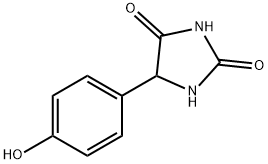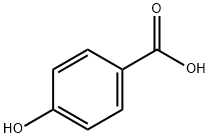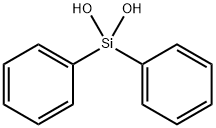5-(4-Hydroxyphenyl)-2,4-imidazolidinedione
- CAS NO.:2420-17-9
- Empirical Formula: C9H8N2O3
- Molecular Weight: 192.17
- MDL number: MFCD00044002
- EINECS: 219-340-8
- SAFETY DATA SHEET (SDS)
- Update Date: 2025-09-25 17:15:13

What is 5-(4-Hydroxyphenyl)-2,4-imidazolidinedione?
Flammability and Explosibility
Non flammable
Synthesis
Add 4.0 g of glyoxylic acid monohydrate (0.04 mol), 1.2 g of urea (0.02 mol), and 10 mL of 10% hydrochloric acid into the beaker. Stir evenly. After releasing the heat, pour it into a dropping funnel and set aside. Add 3.6 g (0.06 mol) of urea, 5.6 g (0.06 mol) of phenol, and 10% hydrochloric acid, and stir evenly in a three-necked flask. Heat to 90 ℃, slowly add the glyoxylic acid-urea mixture dropwise and control the dropping speed for about 4 hours. After the dropwise addition is completed, continue the heat preservation reaction for 2 hours to complete the reaction. Change the reaction device to a vacuum distillation device to recover excess phenol. After evaporating about 1/3 of the volume of the solution, cool to about 15°C to crystallize, filter, and use the filter cake. Wash with water 2 to 3 times until neutral and dry to obtain 5.8 g of white solid 5-(4-Hydroxyphenyl)-2,4-imidazolidinedione.
Properties of 5-(4-Hydroxyphenyl)-2,4-imidazolidinedione
| Melting point: | >260°C |
| Boiling point: | 273.7℃[at 101 325 Pa] |
| Density | 1.408 |
| vapor pressure | 0Pa at 25℃ |
| storage temp. | Inert atmosphere,Room Temperature |
| form | powder to crystal |
| pka | 8.67±0.10(Predicted) |
| color | White to Almost white |
| Water Solubility | 1.29g/L at 20℃ |
| InChI | InChI=1S/C9H8N2O3/c12-6-3-1-5(2-4-6)7-8(13)11-9(14)10-7/h1-4,7,12H,(H2,10,11,13,14) |
| CAS DataBase Reference | 2420-17-9(CAS DataBase Reference) |
Safety information for 5-(4-Hydroxyphenyl)-2,4-imidazolidinedione
| Signal word | Danger |
| Pictogram(s) |
 Corrosion Corrosives GHS05  Exclamation Mark Irritant GHS07  Environment GHS09 |
| GHS Hazard Statements |
H315:Skin corrosion/irritation H318:Serious eye damage/eye irritation H411:Hazardous to the aquatic environment, long-term hazard |
| Precautionary Statement Codes |
P264:Wash hands thoroughly after handling. P264:Wash skin thouroughly after handling. P270:Do not eat, drink or smoke when using this product. P273:Avoid release to the environment. P280:Wear protective gloves/protective clothing/eye protection/face protection. P391:Collect spillage. Hazardous to the aquatic environment P332+P313:IF SKIN irritation occurs: Get medical advice/attention. P501:Dispose of contents/container to..… |
Computed Descriptors for 5-(4-Hydroxyphenyl)-2,4-imidazolidinedione
| InChIKey | UMTNMIARZPDSDI-UHFFFAOYSA-N |
| SMILES | C1(=O)NC(C2=CC=C(O)C=C2)C(=O)N1 |
New Products
4,4-Difluoropiperidine hydrochloride tert-butyl 9-methoxy-3-azaspiro[5.5]undecane-3-carboxylate Indole Methyl Resin N-Isopropylurea N,N-Dicyclohexylcarbodiimide(DCC) MELDRUMS ACID 5-METHYLISOXAZOLE-4-CARBOXYLIC ACID Magnessium Bis glycinate Zinc ascorbate 1-bromo-2-butyne 2-acetamidophenol 9(10H)-anthracenone Erythrosin B, 4-Piperidinopiperidine 2-((4-morpholinophenylamino) (methylthio) methylene) malononitrile 2,4-dihydroxybenzaldehyde 3-(4-morpholinophenylamino)-5-amino-1H-pyrazole-4-carbonitrile Methyl 2-methylquinoline-6-carboxylate 2,6-dichloro-4-nitropyridine 4-Bromo-2-chlorobenzonitrile 2-(benzylamino)acetic acid hydrochloride 4-(tert-Butoxycarbonylamino)but- 2-ynoic acid 3,4-dihydro-2H-benzo[b][1,4]dioxepine 1-Phenyl-1-cycloprppanecarboxylicacidRelated products of tetrahydrofuran








You may like
-
 5-(4-Hydroxyphenyl)hydantoin CAS 2420-17-9View Details
5-(4-Hydroxyphenyl)hydantoin CAS 2420-17-9View Details
2420-17-9 -
 3-(4-amino-1-oxoisoindolin-2-yl)-1-methylpiperidine-2,6-dione 98%View Details
3-(4-amino-1-oxoisoindolin-2-yl)-1-methylpiperidine-2,6-dione 98%View Details -
 614-19-7 98%View Details
614-19-7 98%View Details
614-19-7 -
 3112-85-4 Methyl phenyl sulfone 98%View Details
3112-85-4 Methyl phenyl sulfone 98%View Details
3112-85-4 -
 20677-73-0 (2,2-diethoxyethyl)methylamine 98%View Details
20677-73-0 (2,2-diethoxyethyl)methylamine 98%View Details
20677-73-0 -
 3-(4-(hydroxyamino)-1-oxoisoindolin-2-yl)piperidine-2,6-dione 98%View Details
3-(4-(hydroxyamino)-1-oxoisoindolin-2-yl)piperidine-2,6-dione 98%View Details -
 57381-49-4 2-bromo-4-chlorobenzonitrile 98%View Details
57381-49-4 2-bromo-4-chlorobenzonitrile 98%View Details
57381-49-4 -
 4,6-dichloropyrimidine-5-carbaldehyde 98%View Details
4,6-dichloropyrimidine-5-carbaldehyde 98%View Details
5305-40-8
